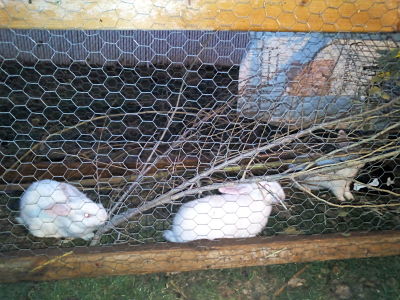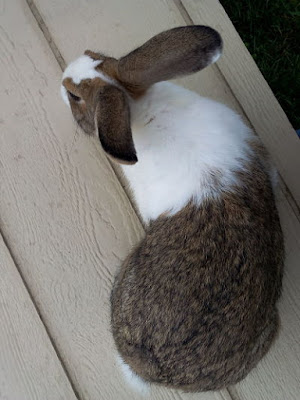Since it's summer time, we've been sleeping with the bedroom window open. I've got two does due to kindle in about ten days. They have gained weight and and I've been hearing them being restless and rattling and digging on everything in their pens. Pretty good signs they are indeed pregnant. Breeding stock I've had in the past usually don't start nest building until within two days or the day before giving birth. This line starts two weeks before.
Since we feed a lot of tree branches, I accumulate a rather large pile quickly and some are pretty thorny. We do use some for grilling or smoking meat but most I run through an electric chipper. I save the chips in a feed bag after they have dried. Instead of buying pine shavings I've been using these wood chips in the nest boxes.
My nest boxes are permanently attached to my hutches and are large, about 24x16x12 inches. I worried about the size being too big but they have been working well, I believe due to using a few inches of wood chips or shavings in the bottom. The solid bottom, I do not like because the babies end up using the box as a toilet and they become a mess to clean. I'll eventually put a wire bottom and use a cardboard liner. The rabbits love these attached boxes as a place to hang out or if they ever feel threatened, the box is a refuge, like a burrow would be in the wild. In the very distant past, I did on occasion let a doe dig a burrow for her litter, with generally good success but I have much less loss with these attached boxes.
Traditional nest boxes that you put inside the cage work fine. The main concern on a nest box is that after it's filled with bedding, you want a couple inches of lip on the entrance so babies do not get dragged out after their mother feeds them. Some latch on to a teat too hard as their mother leaves.
One thing that has really impressed me with using hutches with permanently attached nest boxes, even for bucks, is that if you ever sell the rabbits with the hutch, just load the hutch on a trailer, rabbits and all. The rabbits will go inside their refuge and feel perfectly safe speeding down the interstate at 75 mph.
The key to a good nest for extreme cold or hot weather is to have a few inches of wood chips in the bottom. Then dry grass, straw, shredded paper or similar on top and filling the corners. The doe will dig away some of the chips to form an indentation big enough to put her babies, about the size of a cereal bowl. The other materials get pushed around and fill out the corners where otherwise a kit could get stuck and potentially chilled. In the winter I fill the box with dry grass or shredded paper, just very lightly so it's not packed. She'll push them around and they tend to form almost a tunnel from the entrance to the hollowed spot in the back corner.
Before giving birth or even during, the doe will pull hair and use it as lining in the depression. Sometimes I'll also add some dryer lint if I'm concerned there is not enough pulled fur or it's especially cold. You can have too much fur too. I've seen babies get wrapped in a thick wad of fur and get isolated or smothered. If too much, I'll remove the extra and put it in a bag in case more is needed later or another doe doesn't pull enough. There should be just enough fur that they can fluff it up and stay cozy underneath. It's not uncommon for the young kits to push the fur down and spread out more during the heat of the day and then gather together close at night and fluff back up the fur that is matted at the bottom. The babies do this themselves with their movement, not the mother.
Doe rabbits are not like mother cats, who will return lost babies or move them to a safer place. If a hairless baby gets tangled in bedding, dragged out of the nest or just stuck in a corner, she'll do nothing to save it or put it back with the others. The mother only gives them attention to feed them. She will just hover over her kits and let them feed and may lick them clean. This only happens once or twice a day so you may never see it. Just look for fat baby tummies. I try to check the nest daily. I remove any that may have died, and make sure it's not easy for the kits to leave the nest by making sure corners are filled and that there is just one depression with everything sloped slightly toward the depression.
During extreme heat, usually if it gets over 95F, I will take any babies under ten days old inside to stay cool. After noon, we put them in a box with some of their mother's fur and the same bedding that was in the nest. Once the sun goes down we take them back to the nest with their mother. I've never had a problem with the mother rejecting them. If a doe were to reject her babies, I would not keep her. Older kits handle the heat better, I believe because their digestive system has become more stabilized with good bacteria. By that age the babies will already have been chewing on nest bedding and any manure pellets their mother left in the nest. If you see a few of the does' dropping in the nest, leave them, they are important for digestive inoculation of probiotic bacteria, so the kits can eat the same food as their mother without getting diarrhoea.
If you have plenty of wood chips and plenty of other bedding and the doe has been able to make a nice tunnel to her babies through it, cold winter weather is easy. After they get more fur and can handle the weather, you may need to remove some bedding as they grow and take up space. Sometimes I'll expand the depression so the pile is not so deep causing those on the bottom to smother. Little things can make a big difference in the survival rate.
When a doe has babies on the wire and doesn't build a nest. Try building one for her and put the babies in it. There is a good chance she'll still care for them.
I've never had an issue with a mother abandoning her babies because I touched them. If I did, I'd cull the doe. While the kits are young, it's easy to give some extras from a doe with a huge litter to one that has a small litter. I've never had a problem with the mother killing them except in a couple of situations where an older kit, over three weeks old got put back in the wrong cage and most of my does will even tolerate that. I do limit the handling sessions to at the most twice a day and only for a few minutes.
Hopefully this will give you some ideas that will help you wean more kits.















.jpg)














